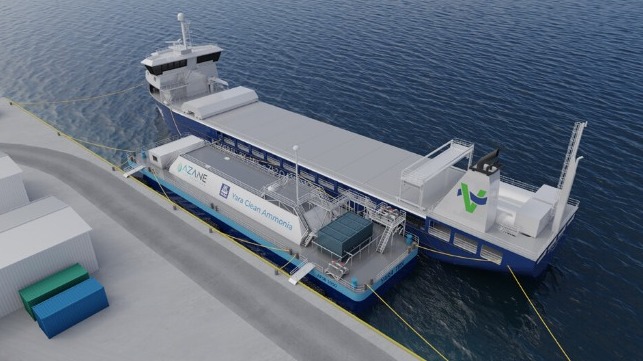Yara Plans First Scandinavian Ammonia Bunker Network

In a step designed to build the infrastructure needed to support the adoption of ammonia as a maritime fuel, Yara International and Azane Fuel Solutions signed a deal to create an ammonia fuel bunker network for Scandinavia. Through this agreement, Yara expects to make green ammonia available as fuel for ships in Scandinavia by 2024.
To support the launch of the network, Yara International has pre-ordered 15 floating bunkering terminals from Azane Fuel Solutions. The ammonia bunker terminals will be designed and constructed by Azane to enable shipping fleets’ uptake of emission-free green ammonia as fuel. They will be delivered to Yara, the global fertilizer company, which as one of the world's largest ammonia producers will use its position to deliver green ammonia to the shipping industry. The bunker network plan is the latest in a series of steps taken by Yara to produce ammonia from renewable energy to make it available as a “green” fuel source.
"These bunkering terminals are key pieces of the puzzle to ensure reliable and safe ammonia supply as zero-emission fuel,” said Magnus Krogh Ankarstrand, President of Yara Clean Ammonia. “Yara is excited to be a part of the project and to own and operate the first operational ammonia fuel terminals in the world."
Azane, a Norwegian ammonia bunkering technology company, working with AMON Maritime and ECONNECT Energy is seeking to develop and construct the first pilot unit as part of a project that received public funds from Norway's Green Initiative program last year. Along with grants from Innovation Norway and the Norwegian Research Council, they will fund the pilot terminal.
Yara's bunker terminals will be either barge-based or land-based. Both terminal designs will have storage tanks and processing capacity for the storage, handling, and transfer of ammonia. The bunker terminal is designed for loading and unloading to and from ships and with the option for truck loading and unloading.
Industry analysts have highlighted the importance of developing the infrastructure required to support the adoption of new fuels. They have noted that the bunkering industry must move forward in developing the technologies and processes required for the safe handling of fuels such as ammonia which have different properties and requirements from traditional fuels and even other gas-based fuels such as LNG.
"For those of us who build ships that will run on green ammonia, this agreement means that we can be sure that the fuel is available for delivery when the first vessels are ready," said André Risholm, CEO at Amon Maritime, Board member of Viridis Bulk Carriers and Chairman of Azane Fuel Solutions.
Viridis Bulk Carriers, formed in Norway in 2020, is one of several companies seeking to develop a zero-emission shipping network. They received funding from the Norwegian government, which is being used in the development of vessels using reciprocating engines that will burn ammonia and use an exhaust gas after-treatment system optimized for ammonia along with batteries and shore power to create an ammonia-electric hybrid power system. The vessels will be able to steam more than 3,000 nautical miles between bunkering. The goal is to complete the designs this year and have the first vessels in service by 2024.
